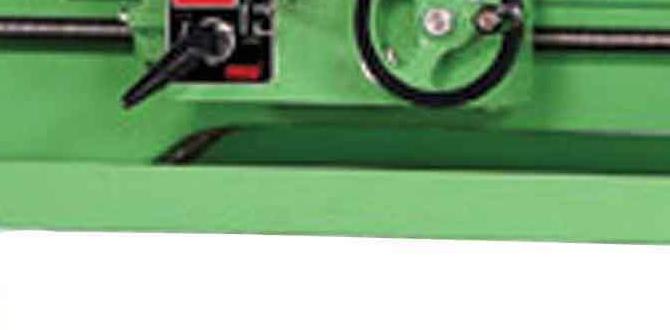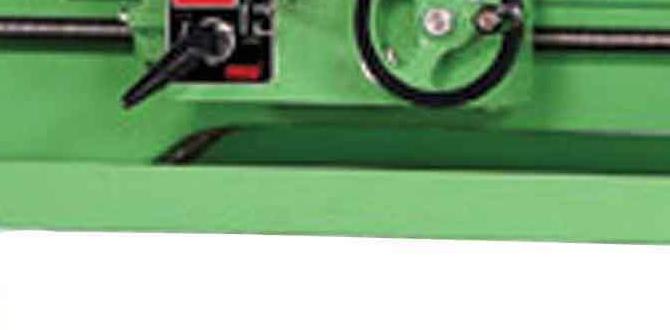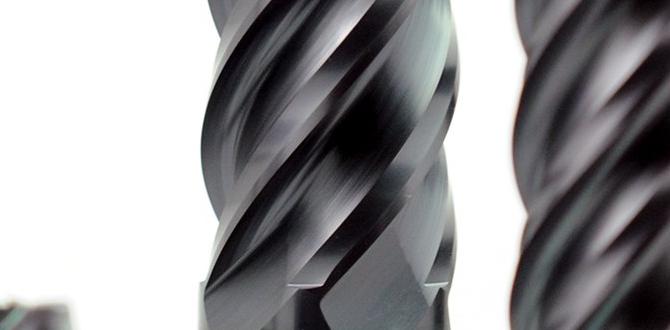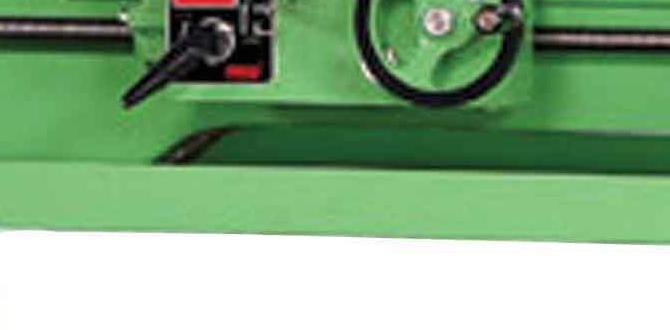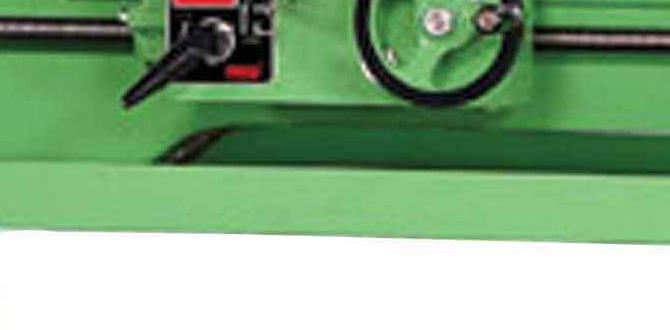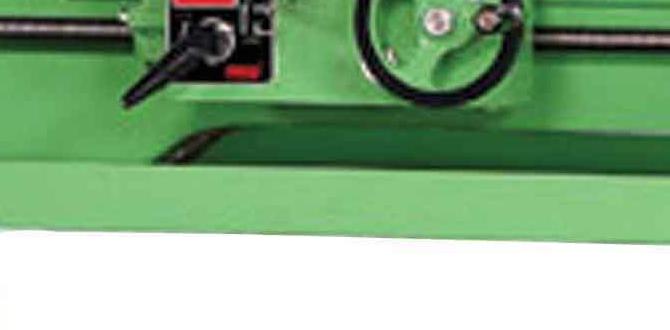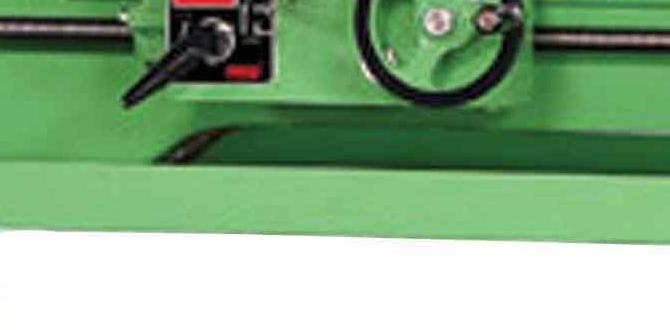Wood lathe vibration dampeners can significantly smooth out operation, reduce noise, and improve workpiece finish by absorbing unwanted shaking during turning. Investing in the right dampeners is a cost-effective way for any woodturner to achieve better results and a more enjoyable shop experience, directly addressing common lathe vibration issues.
Hey there, fellow woodworkers and aspiring lathe enthusiasts! Daniel Bates here, from Lathe Hub, ready to tackle a common frustration that creeps into many a workshop: wood lathe vibration. You know the feeling – that annoying wobble that can make your cuts rough, your finishes fuzzy, and your ears ring. It’s like trying to paint a masterpiece with a shaky hand! But don’t worry, this isn’t something you just have to live with. There are some fantastic gadgets designed specifically to combat this, and we’re going to dive deep into a wood lathe vibration dampeners review that will help you find the perfect solution. We’ll sort through the options, understand what makes them work, and get you back to smooth, satisfying turning in no time. Stick around as we explore the best ways to silence those shakes!
Why Do Wood Lathes Vibrate? Understanding the Shake
Before we get into the exciting world of vibration dampeners, let’s take a moment to understand why our beloved wood lathes sometimes get a bit jumpy. It’s not magic, and it’s not usually a sign of a broken machine (phew!). Instead, vibration is a natural consequence of the lathe’s operation and the materials we work with.
Think of it like this: a spinning workpiece, especially one that’s not perfectly balanced or if it has an irregular shape, creates an uneven force. This force is transferred to the lathe bed and the entire machine. When that force hits a resonant frequency – a speed or condition where its effects are amplified – you get noticeable vibration. It’s like pushing a swing; if you push at just the right time, it goes higher. With a lathe, the “push” is the imbalance, and the “swing” is the machine itself.
Here are the main culprits:
- Imbalanced Workpieces: This is the big one! When you start turning a freshly mounted piece of wood, it’s often not perfectly round or evenly weighted. As it spins, the heavier sections exert more force, creating an imbalance that leads to vibration. Even stable, round pieces can develop this if there are internal stresses or knots that aren’t uniform.
- Tool and Technique: Aggressive cuts, especially with dull tools or at the wrong angle, can introduce sudden forces that jolt the workpiece and the lathe.
- Machine Setup: A lathe that isn’t sitting level or is placed on a flimsy base can amplify vibrations. The inherent design and weight of the lathe also play a role; heavier lathes generally vibrate less than lighter ones.
- Wood Density and Moisture: Denser woods or woods with uneven moisture content can sometimes contribute to imbalance and vibration as they’re turned.
The good news is that most of these issues can be managed, and vibration dampeners are a fantastic way to take a big bite out of the problem, especially the ones related to workpiece imbalance and machine resonance.
What Exactly ARE Wood Lathe Vibration Dampeners?
Simply put, wood lathe vibration dampeners are inserts or pads designed to be placed between the lathe and its stand, or sometimes directly under the workpiece (though this is less common for general operation). Their primary job is to absorb and dissipate the shock and vibration generated during the turning process.
Imagine placing a thick rubber mat under a noisy washing machine. The mat absorbs some of the banging and rattling. Lathe dampeners work on a similar principle, but they’re engineered with specific materials and designs to handle the unique forces of a spinning lathe. They act as a buffer, preventing the vibrations from traveling up into the lathe bed and out into your workshop.
These dampeners are typically made from dense, energy-absorbing materials like:
- Rubber: Thick, industrial-grade rubber is a common and effective choice. It has good shock-absorbing properties.
- Polyurethane: Another durable and resilient material that can handle significant impact and vibration.
- Specialized Composite Materials: Some manufacturers develop proprietary blends designed for optimal vibration dampening.
They come in various shapes and sizes, often as four separate pads that fit under the corner feet of a lathe stand, or sometimes as a single mat. The goal is always the same: to create a stable, vibration-resilient foundation for your turning.
Benefits of Using Vibration Dampeners
So, why go through the trouble of adding dampeners? The benefits are numerous and can dramatically improve your woodworking experience, whether you’re a seasoned pro or just starting out.
Smoother Finishes
This is often the most noticeable benefit. When your lathe is shaking, it’s incredibly difficult to achieve a perfectly smooth surface, especially with fine scrapes. Vibration dampeners help stabilize the lathe, allowing your tools to make cleaner, more consistent contact with the wood. This translates directly into a finer finish, meaning less sanding for you. And who doesn’t want less sanding?
Reduced Noise Levels
Vibrations are noisy! When your lathe shakes, it rattles. It buzzes. It can make for an unpleasant atmosphere in your workshop, especially if you work with others or if your neighbors are close by. Dampeners absorb a significant amount of this mechanical noise, creating a quieter, more peaceful working environment.
Increased Tool Life
Constant jolting and vibration can put extra stress on your turning tools. This can lead to dulling them faster or even chip the cutting edges. By stabilizing the lathe, dampeners reduce this abusive impact on your tools, helping them stay sharper for longer and saving you money on resharpening or replacements.
Improved Safety
While not a substitute for safe operating practices, controlling vibration contributes to overall workshop safety. A lathe that’s bouncing around is less predictable and harder to control. Stable operation means a more predictable tool path and less chance of an accident. For more on lathe safety, the Woodturners Guild of New Zealand offers some excellent safety resources.
Enhanced Machine Longevity
Just like your tools, the lathe itself experiences wear and tear from excessive vibration. The bearings, motor, and structural components can be stressed over time. By absorbing shock, dampeners can help reduce this cumulative stress, potentially extending the lifespan of your lathe.
Better Turning Experience
Ultimately, all these benefits add up to a more enjoyable and less frustrating turning session. Less noise, smoother cuts, and a more stable machine make the whole process more satisfying and allow you to focus on the creative aspect of turning rather than fighting the machine.
Types of Wood Lathe Vibration Dampeners
When you start looking for vibration dampeners, you’ll find they generally fall into a few categories based on their design and how they’re used. Understanding these differences will help you choose the best fit for your lathe and your workshop.
Individual Pad Dampeners
These are the most common type. They typically come as a set of four, designed to be placed directly under each of the feet of your lathe’s stand. They often look like thick, dense rubber or polyurethane squares or discs.
- Pros:
- Easy to install – just lift each corner of the stand and slide them underneath.
- Universal fit for most lathe stands with separate feet.
- Good for isolating the lathe from the floor.
- Cons:
- May shift slightly if the lathe has very aggressive vibrations.
- Effectiveness can vary based on the density and thickness of the material.
Full Mat Dampeners
Less common for smaller lathes, these are typically larger, solid mats designed to go under the entire base of the lathe stand. They offer a broader surface area for vibration absorption.
- Pros:
- Can offer excellent stability due to the larger contact area.
- Less likely to shift than individual pads.
- Cons:
- Might be overkill for smaller lathes.
- Can be more expensive.
- Requires a stand that can accommodate a full mat.
Integrated Vibration Dampening Stands
Some higher-end or specialized lathe stands are designed with built-in vibration dampening systems. This might involve specialized rubber mounts or internal damping mechanisms.
- Pros:
- Often the most effective solution as it’s integrated into the design.
- Seamless integration and aesthetic.
- Cons:
- Significantly more expensive than aftermarket dampeners.
- Not an upgrade option for an existing lathe.
For most beginner and intermediate woodturners, the individual pad dampeners offer the best balance of effectiveness, affordability, and ease of use. We’ll focus our review on these.
Review of Popular Wood Lathe Vibration Dampeners
Alright, let’s get down to business. I’ve looked at several popular options that are readily available for woodworkers. The key factors I’m considering are material quality, thickness, size, stability, and overall value. Remember, what works best can depend on your specific lathe and the types of wood you turn.
Option 1: Heavy-Duty Rubber Isolation Pads
These are your workhorses – often found under industrial equipment and readily adapted for woodworking. They’re usually made from thick, high-density natural or synthetic rubber.
- Description: Typically sold in sets of four, these are dense rubber pads, often with a ribbed or textured surface for grip. They’re designed to handle significant weight and absorb impact. Common dimensions might be around 4″x4″ or 6″x6″ with thicknesses ranging from 1″ to 2″.
- Material: High-density, industrial-grade rubber.
- Thickness: 1″ to 2″.
- Best For: Medium to large wood lathes, especially those producing heavier turnings or experiencing significant vibration.
- Pros:
- Excellent vibration absorption due to material density and thickness.
- Durable and long-lasting.
- Generally very affordable.
- Good grip prevents feet from sliding.
- Cons:
- Can be a bit bulky.
- Some may have a strong rubber smell initially.
- Where to Find: Industrial supply stores, online marketplaces (like Amazon, eBay), and some hardware stores. Look for terms like “anti-vibration rubber pads,” “machine mounts,” or “isolator pads.
Option 2: Polyurethane Vibration Pads
Polyurethane is a synthetic material known for its resilience and durability. It offers a slightly different damping characteristic compared to rubber.
- Description: Similar in form factor to rubber pads (sets of four), but made from a more rigid yet still flexible polyurethane compound. They can be very effective at dissipating energy. Often slightly smaller in footprint but the same thickness as good rubber pads.
- Material: High-density polyurethane.
- Thickness: 0.75″ to 1.5″.
- Best For: Lathes where a slightly firmer pad is desired, or for users who prefer the properties of polyurethane over rubber. Good for a wide range of lathe sizes.
- Pros:
- Excellent energy absorption and vibration dampening.
- Resistant to oils and chemicals.
- Very durable.
- Can offer a more responsive feel than softer rubber.
- Cons:
- Can be slightly more expensive than rubber.
- May have less natural “grip” than some rubber compounds, potentially requiring a non-slip layer underneath if your stand feet tend to slide.
- Where to Find: Specialized industrial suppliers, online tool retailers.
Option 3: Recycled Tire Rubber Pads
A more eco-friendly option that uses recycled materials. These are often very dense due to the nature of tire rubber.
- Description: These pads are made from compressed and molded recycled tires. They are typically very dense and heavy, providing substantial damping. They might have a more “industrial” look.
- Material: Molded recycled rubber.
- Thickness: 0.5″ to 1.5″.
- Best For: Heavier lathes, or for users specifically looking for an eco-friendly solution without compromising performance.
- Pros:
- Very dense and effective at absorbing vibrations.
- Environmentally friendly.
- Often very cost-effective.
- Cons:
- Can have a strong tire smell, especially when new.
- Aesthetic might not appeal to everyone.
- Surface texture can vary, impacting grip.
- Where to Find: Online marketplaces, specialized eco-friendly product suppliers.
Option 4: Dedicated Wood Lathe Dampens (Often branded)
Some woodworking tool brands offer their own branded vibration dampening solutions. These are often styled to match their tools and feature specific material blends.
- Description: These are usually shaped individually padded feet, marketed specifically for wood lathes. The material might be a proprietary rubber or polymer blend. They often feature specific ergonomic shapes to match lathe feet.
- Material: Proprietary rubber or polymer compounds.
- Thickness: 0.75″ to 1.75″.
- Best For: Users who prefer a product specifically designed and marketed for their wood lathe, often with a more refined aesthetic. Good for a wide range of lathes.
- Pros:
- Designed with wood lathes in mind, ensuring compatibility and effectiveness.
- Often have a cleaner aesthetic.
- Good vibration dampening properties.
- Cons:
- Generally more expensive than generic industrial pads.
- Performance is highly dependent on the specific brand’s material quality.
- Where to Find: Major woodworking tool retailers (e.g., Grizzly Industrial, Rockler, Woodcraft), dedicated woodworking online stores.
Comparison Table
To help visualize, here’s a quick comparison of what you might find on the market:
| Feature | Heavy-Duty Rubber Pads | Polyurethane Pads | Recycled Tire Rubber Pads | Branded Woodworking Pads |
|---|---|---|---|---|
| Primary Material | Natural/Synthetic Rubber | Polyurethane | Molded Recycled Rubber | Proprietary Blend (Rubber/Polymer) |
| Typical Thickness | 1″ – 2″ | 0.75″ – 1.5″ | 0.5″ – 1.5″ | 0.75″ – 1.75″ |
| Vibration Dampening | Excellent | Very Good to Excellent | Excellent | Good to Excellent |
| Durability | Excellent | Excellent | Very Good | Very Good to Excellent |
| Cost | Low to Medium | Medium | Low | Medium to High |
| Best For | General use, heavier lathes | Balanced performance, oil resistance | Heavy lathes, eco-conscious users | Aesthetic appeal, ease of purchase |
| Potential Downsides | Bulk, initial odor | Slightly less grip than some rubber | Odor/aesthetic, variable grip | Higher cost |
How to Choose the Right Dampeners for Your Lathe
Selecting the perfect vibration dampeners involves a few simple considerations. Don’t overthink it – the goal is to get something that’s going to work well for your situation. Here’s a quick guide:
- Consider Your Lathe’s Size and Weight: Heavier lathes generally produce less vibration to begin with, but they can also cause more forceful vibrations when imbalanced. For lighter benchtop lathes, a moderately thick rubber pad might be ideal. For larger floor-standing lathes, you’ll want thicker, denser pads to handle the load and energy.
- Check Your Lathe Stand’s Feet: Most dampeners are designed to go under the individual feet of a lathe stand. Measure the size of your lathe’s feet to ensure the dampener pads will fit securely underneath without being too small and unstable, or too large and awkward. A pad that’s at least as wide as your lathe’s foot is a good starting point.
- Material Matters:
- Rubber: Offers a good balance of cushioning and stability, and it’s usually the most cost-effective.
- Polyurethane:

